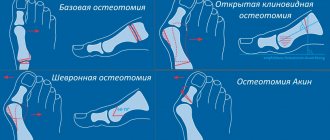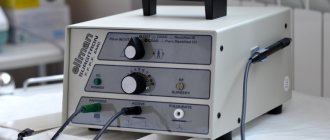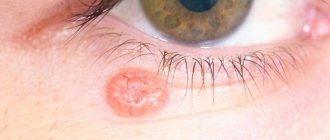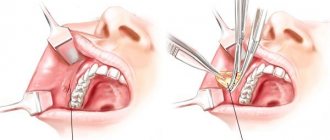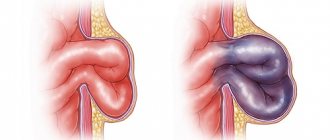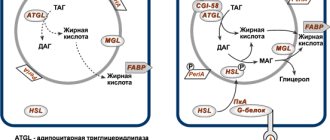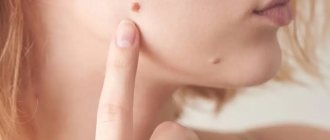Classification of the skin-fat apron
Skin-fat deformation has the appearance of a hanging fold of fat, the severity of which is determined by the plastic surgeon. This cosmetic defect has the following levels of deformation:
- 1st degree - lowering of the fold to the level of the pubis;
- 2nd degree - the fold descends to the organs of the reproductive system;
- 3rd degree - sagging of the fold to the third of the thigh;
- 4th degree - sagging of the fat fold to the middle of the thighs;
- 5th degree - lowering the fold to the level of the knees.
Each level of skin-fat deformation has its own difficulties, characteristics and pain.
Symptoms of skin-fat deformation
The symptoms of a skin-fat apron are quite specific. When this deformation occurs, a person experiences an unpleasant feeling during sexual intercourse and problems with the genitourinary system. In the first three stages of the skin-fat apron, its symptoms are limited only to an aesthetic problem and discomfort. The fourth and fifth stages are characterized by such signs as the appearance of diaper rash, itching, a feeling of irritation and a sharp unpleasant odor in the folds of skin and fat deformation and pain in the abdominal area.
Possible complications after removing the fat “apron” on the abdomen
Abdominoplasty and panniculectomy are well-known and frequently performed operations. Doctors are well aware of the stages of manipulation and can foresee some difficulties after examining and interviewing the patient. If the surgeons carried out their work competently, and the patient turned out to be conscientious and complies with all recommendations for rehabilitation without exception, then complications arise extremely rarely, as an exception.
Possible complications after removing the “apron” on the stomach using abdominoplasty:
- bleeding and hematoma formation;
- suture infection;
- tissue necrosis in the area of suturing the surgical wound;
- problems with abdominal sensitivity (it decreases or disappears altogether).
Consequences of abdominoplasty
Complications include the formation of too rough scars - this is an unsatisfactory result from an aesthetic point of view. To prevent this from happening, the surgeon must have the skill and experience of performing cosmetic sutures.
Panniculectomy has a smaller list of complications:
- formation of subcutaneous hematomas;
- suppuration of the suture (infection);
- loss of skin sensitivity;
- scarring of the seam.
If the patient does not comply with the rules of the recovery period, the sutures may come apart, which leads to the need for repeated surgery.
Result of abdominoplasty
Diagnosis of the skin-fat apron
If you have the first two degrees of manifestation of skin-fatty deformation, you should seek advice from a dermatologist, therapist, cosmetologist, plastic surgeon and nutritionist. To determine the cause of this defect, the following diagnostic examinations are used:
- physical examinations by specialists;
- passing general clinical tests;
- ultrasound examination of the abdominal cavity;
- carrying out magnetic resonance imaging.
After passing tests and conducting a series of studies, the specialist will study the increase and development of skin-fat deformation, and will also choose the appropriate individual treatment method.
Surgeries to remove the “apron” on the abdomen
The problem can be solved by two methods: abdominoplasty and panniculectomy. Often these operations are combined with liposuction, and in this case we are talking about more complex work for the surgeon and a longer rehabilitation process.
Abdominoplasty to get rid of the “apron”
This involves the use of general anesthesia and correction of not only the skin, but also muscle fibers and fat. Abdominoplasty lasts on average 1-4 hours and has the following advantages:
- the “apron” is eliminated regardless of what stage of obesity is present or how severe the problem is;
- the result is truly amazing, because the stomach literally becomes flat due to muscle tightening;
- the resulting effect lasts for life, but only if pregnancy and childbearing are not expected in the future.
Abdominoplasty
Abdominoplasty surgery to remove the “apron” on the stomach is carried out in several stages:
- The surgeon makes an incision in the lower abdomen and peels away the fat layer from the skin.
- The navel is separated from its usual location.
- The doctor eliminates hernias (if any, which is common for obese people), and solves the problem of muscle tissue discrepancies.
- Excess skin and fat are excised, and the remaining tissue is pulled towards the pubis.
- The navel is fixed in a new place, the surgeon sews up the incision, and applies a sterile bandage.
Plastic correction of the skin-fat apron
Plastic correction of the skin-fat apron involves a surgical operation such as abdominoplasty. Indications for plastic correction of skin-fat deformation will be the presence of varying degrees of prolapse. Before the operation, the patient’s weight must be stable for a year, and exercise and diet therapy are also recommended.
Contraindications to plastic correction of skin-fat deformation include:
- severe obesity;
- pregnancy planning;
- the presence of postoperative scars above the umbilical region;
- decompensated form of diabetes mellitus;
- oncological diseases.
Preparing for surgery
The patient who applies for the procedure must understand that this is a serious and complex surgical intervention. After it, a fairly wide visible scar remains on the stomach, and you will have to live with it for the rest of your life. In addition, you will need to undergo serious preparation for the operation to remove the “apron” from the abdomen, which includes:
- Compliance with a low-calorie diet and regular exercise for a minimum of 6 months, a more precise period is determined by the doctor. This will not only lead to active, but non-aggressive weight loss, but will also strengthen the muscle frame. The result will be an easier rehabilitation period.
- Refusal 15 days before surgery from drinking alcoholic beverages, smoking and taking certain medications that negatively affect the blood clotting system (Aspirin, Ibuprofen, etc.). Doctors recommend interrupting the course of taking contraceptives, as they contribute to the formation of blood clots, which can result in bleeding during surgery and in the postoperative period.
- Conducting therapy for previously diagnosed chronic pathologies of internal organs and systems. The primary care physician should be notified of the upcoming surgery and the need to put the disease into stable remission.
During the preparatory period, the patient must undergo a comprehensive examination, since surgery is performed under general anesthesia, and there are many contraindications to this.
Preparation for tummy tuck
Methods for removing skin-fat apron
There are various technologies for performing abdominoplasty; before performing them, it is necessary to undergo an extensive medical examination to determine contraindications. The essence of abdominoplasty is to peel away the front part of the peritoneal wall and move it lower, while excess fat and skin are removed. Before suturing the wound, silicone drains are installed to ensure timely drainage of fluid, after which continuous skin sutures are installed in layers.
The following methods for removing skin-fat deformation are distinguished:
- Dermatolipectomy (panniculectomy) is an operation that makes it possible to eliminate excess skin and fat. It consists of dissecting the skin-fat fold in the abdominal area and can be combined with herniotomy and hysterectomy;
- Liposuction is the limited removal of fat through minor punctures using a cannula;
- Local abdominoplasty is an operation in the lower abdomen, which is performed without transferring the navel. This type of abdominoplasty is used to eliminate minor aesthetic defects and stretch marks that appear during pregnancy;
- Extended abdominoplasty is a technology for removing skin and fat deformation, which requires relocation of the navel, which helps to give a natural and harmonious appearance to the abdomen. Extended abdominoplasty is prescribed when the defect reaches a large size and if it is necessary to completely correct the tissues of the abdominal wall;
- Mini abdominoplasty is a surgical intervention that involves cutting excess skin in the anterior peritoneum area and does not involve transferring the navel. In most cases, mini abdominoplasty is combined with liposuction.
Contraindications
They are standard for any surgical procedure:
- previously diagnosed malignant neoplasms in any organ or system of the body;
- acute infectious and inflammatory processes, including exacerbation of chronic pathologies;
- unstable psyche;
- any neurological pathologies, including epilepsy;
- unstable blood pressure is a conditional contraindication, it can be corrected and stabilized;
- history of coronary heart disease, strokes, atherosclerosis, thrombophlebitis;
- bronchial asthma.
The final decision is made by the primary attending physician and the surgeon who will perform the operation to remove the “apron” on the abdomen. If necessary, additional examinations will be prescribed and specialized specialists will be involved.
Indications for tummy tuck
Rehabilitation period after removal of the skin-fat apron
After plastic correction of skin-fat deformation, the patient requires a long recovery period. Discharge from the hospital occurs on the second day, but specialists monitor the condition of the patient’s abdominal wall for several weeks. Before the surgical sutures are removed, dressings are performed three times a week. After a few days, the installed drainage system is removed. During the recovery period, it is necessary to wear compression underwear and avoid physical activity. The scar after the operation is quite noticeable, but over time it fades and becomes soft, but does not completely disappear.
Recovery and rehabilitation after
Regardless of which method of removing the “apron” on the abdomen was chosen and approved by the doctor, rehabilitation after the operation lasts on average 1 month. In some cases, it can last 1.5 or 2 months, it all depends on the general health of the patient and the presence or absence of postoperative complications.
What surgeons recommend for quick and effective rehabilitation:
- Until the stitches are removed, do 2-3 dressings a day. During this procedure, the wound must be treated and examined for the onset of complications, so you should not perform such a manipulation yourself.
- You should wear a special compression bandage for 2 months ; it will help normalize the muscles and tighten the skin. In some cases, if the operation to remove the “apron” was not carried out against the background of a recently resolved problem of severe obesity, doctors prescribe wearing a bandage only for 30 days.
- During the first 1.5-2 months, you need to completely avoid any physical activity . We are talking not only about playing sports, but also about specific work activities with lifting weights, washing floors without a mop, carrying buckets of water and other household chores.
- You should follow a diet for a month that will ensure normal bowel function and no constipation. Patients are allowed to consume liquid and semi-liquid foods: fruit and vegetable purees, soups, milk and fermented milk products. It is worth giving up white cabbage, fatty meats, and legumes. They provoke increased gas formation and increase the risk of constipation.
Compression garments after tummy tuck
As a rule, a month after surgery, a visit to the doctor is required. The specialist must evaluate the condition of the stitches, appearance, the result of his work and, if necessary, adjust rehabilitation measures.
Complications of plastic correction of the skin-fat apron
Any of the technologies used for plastic correction of the skin-fat apron can provoke the appearance of such undesirable complications:
- infection of a postoperative wound;
- seroma formation;
- bleeding;
- temporary loss of sensitivity in the area of the surgical incision;
- formation of an unaesthetic scar.
To prevent the consequences and if there is pain in the suture area, the specialist prescribes the patient to take painkillers and antibiotics. After surgery, for the first time, it is recommended to avoid physical activity, visiting the sauna and solarium. After eliminating the skin-fat apron, the stomach will gain a toned and slim appearance for a long time, if you eat well, maintain a normal weight, engage in moderate regular physical activity and lead a healthy lifestyle.
Cost of the operation
There is no clear price for the operation to remove the “apron” from the abdomen; much depends on the amount of work to be done, the complexity of the manipulation, the risks involved, the reputation and level of the clinic. Prices start at 100,000 rubles and can reach 500,000 rubles.
Many patients prefer to go for such operations to regions where the cost is much lower.
We recommend reading the article about laser liposuction of the abdomen. From it you will learn about the method of getting rid of excess fat, the procedure, features of rehabilitation and possible consequences, cost.
Read more about non-surgical liposuction here.
Surgical removal of the “apron” from the abdomen is the only option for regaining slimness after general weight loss . It is believed that this work of the surgeon is harmless and quite understandable; possible problems can be anticipated and prevented.
